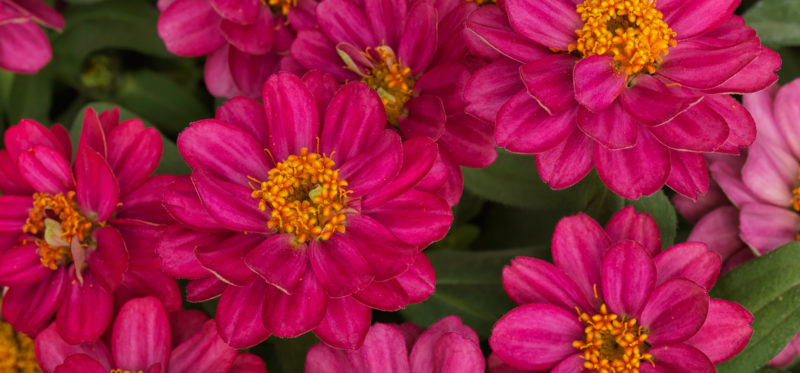
Culture Report: Zinnia Profusion Series
Since the first introduction of ‘Profusion Orange’ in 1994, Sakata has continued to build the Profusion brand with grower-friendly attributes that include toughness and strength. This has resulted in global recognition and accolades following nearly every new color, year after year.
WHY AND HOW DID THIS HAPPEN?
To every grower’s amazement and relief, Profusion zinnia became known as the plant impervious to powdery mildew, and that attribute alone made it a logical choice for their zinnia production needs. When retail buyers saw them, tried them and realized the excellent sell-through at store level, the
requests for more Profusion varieties grew. Once in the garden and in patio containers, consumers sought them and continually request Profusion zinnias year after year. Even Scott Kelly, former astronaut-resident of the International Space Station grew ‘Profusion Orange’, becoming the first flower to germinate, grow and flower in space. Now that’s attitude!
SINCE THEN …
A wide selection of colors, larger flowers, double-flowering (Profusion Doubles), plants that hold up to the heat and bright sun, extreme uniformity in habit and blooming throughout the series … all of these have contributed to the success of Profusion zinnias in sales and outdoor performance.
In some cases, growers wait to schedule zinnia finish dates once warm weather
has arrived. However, because of their durability, Profusion zinnias can be shipped with any other mid-season crop, such as begonia, salvia and vinca. Normally a quick-turn crop, Profusion can be sown, transplanted and finished in as little as seven to eight weeks in large packs, or eight to 10 weeks in larger containers and hanging baskets.
GROWING TIPS
For a successful crop, follow these guidelines:
• During plug stage, maintain media pH at 5.8 to 6.0.
• Radicle emergence will occur in three to four days at 75° F; reduce temperature to 70° F days and 65° F nights.
• Lower moisture levels to medium once true leaves appear.
• Fertilize with calcium-nitrate based formulations at 100- to 150-ppm nitrogen.
• Zinnias are facultative short-day plants (FSDP). Night interruption of four hours will ensure early vegetative growth rather than flowering too early; under short conditions, plants may flower in 15 to 18 days after sowing; daylengths less than 11 hours will hasten flowering.
The following are key cultural points after transplanting.
• Maintain soil EC levels at 1.25 to 1.5.
• Feed plants with nitrate-based fertilizer at 200- to 250-ppm nitrogen.
• Interveinal chlorosis may indicate magnesium deficiency; supplement with MgSO4 (Epsom Salts) at 16 ounces/100 gallons.
• If grown on the lean side and too dry, zinnias may flower prematurely.
• PGR recommendations:
• Daminozide, paclobutrazol and ancymidol are recommended; follow label directions for rates and application methods.
• A negative DIF of 5 to 15 degrees can be utilized to control growth and tone the crop.
• Zinnias are sensitive to boron deficiency, characterized by tip abortion, crinkled leaves and leaf edge burn. Apply 0.25 ppm of boron with each fertilizer application.
‘Profusion Lemon’

ONE MORE OBSERVATION
In many flower beds and decorative containers, deer and rabbits can be an extreme nuisance when they eat the flowers of ornamental plants. Nothing can be more irritating to a consumer to see their hard work and money feed the local wildlife population. Try Profusion since it has been noted in several occasions that deer and rabbits do not eat Profusion zinnias. They’re tough, they’re resilient, they’re disease resistant … it’s just their attitude.


 Video Library
Video Library 




















